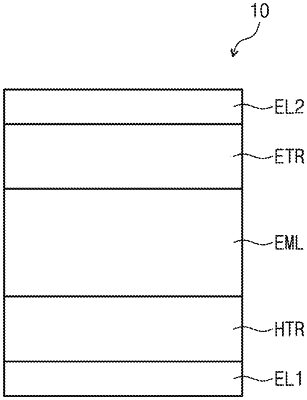| CPC H10K 85/6572 (2023.02) [H10K 85/631 (2023.02); H10K 50/11 (2023.02)] | 20 Claims |

|
1. An organic electroluminescence device, comprising:
a first electrode;
a second electrode disposed on the first electrode; and
a plurality of organic layers disposed between the first electrode and the second electrode,
wherein at least one organic layer among the organic layers comprises a compound represented by Formula 1:
 wherein in Formula 1,
L1 and L2 are each independently a substituted or unsubstituted arylene group of 6 to 30 carbon atoms for forming a ring,
“n” is 0 or 1,
FU is a deuterium atom, a halogen atom, a cyano group, an amino group, a substituted or unsubstituted alkyl group of 1 to 10 carbon atoms, a substituted or unsubstituted alkoxy group of 1 to 10 carbon atoms, a substituted or unsubstituted aryloxy group of 6 to 30 carbon atoms for forming a ring, a substituted or unsubstituted alkylamine group of 1 to 10 carbon atoms, a substituted or unsubstituted arylamine group of 6 to 30 carbon atoms for forming a ring, or a substituted or unsubstituted piperidine group,
FU and DU are different from each other, and
DU is represented by Formula 2:
 wherein in Formula 2,
X is a direct linkage, O, S, or CRaRb,
Ra and Rb are each independently a hydrogen atom, a deuterium atom, a substituted or unsubstituted alkyl group of 1 to 10 carbon atoms, or a substituted or unsubstituted aryl group of 6 to 30 carbon atoms for forming a ring, or combined with an adjacent group to form a ring,
R1 and R2 are each independently a hydrogen atom, a deuterium atom, a halogen atom, a substituted or unsubstituted alkyl group of 1 to 10 carbon atoms, a substituted or unsubstituted alkylamine group of 1 to 10 carbon atoms, a substituted or unsubstituted arylamine group of 6 to 30 carbon atoms for forming a ring, a substituted or unsubstituted aryl group of 6 to 30 carbon atoms for forming a ring, or a substituted or unsubstituted heteroaryl group of 2 to 30 carbon atoms for forming a ring, or combined with an adjacent group to form a ring, and
“a” and “b” are each independently an integer of 0 to 4, and
wherein L2 is an unsubstituted phenylene group when n is 0.
|